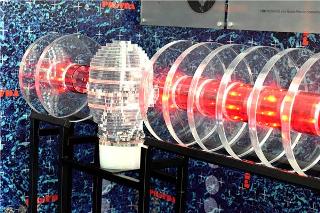Sep 22 2015
A groundbreaking piece of medical imaging technology that could revolutionise cancer treatment will be featured as part of a showcase of 100 engineering ideas that have changed our world.
 PRaVDA2 sml
PRaVDA2 sml
A section of the PRaVDA instrument, developed at the University of Lincoln, UK, for enhancing the treatment of cancer using proton beam therapy, will be included in the Institution of Engineering and Technology’s (IET) new show wall at its Savoy Place headquarters in London.
The IET is the largest professional engineering institution in Europe and its show wall will be a celebration of engineering ideas that have had the biggest impact on humanity. Other items on show include an internal combustion engine, as designed by Karl Benz, and a mechanical television system, which was masterminded by Logie Baird.
The international consortium of researchers behind the PRaVDA (Proton Radiotherapy Verification and Dosimetry Applications) project is led by the University of Lincoln’s Distinguished Professor of Image Engineering Nigel Allinson MBE.
Funded by the Wellcome Trust, he and his multinational team are developing one of the most complex medical instruments ever imagined to improve the delivery of proton beam therapy in the treatment of cancer. The advances they have made in medical imaging technology could make this type of therapy a viable treatment for many more cancer sufferers.
The world-first technology developed by the team uses proton beams to localise treatment, causing less damage to healthy tissue.
Professor Allinson, from the University of Lincoln’s School of Computer Science, said: “It is an amazing honour for our work to be included on the IET’s show wall, and to be up there with some of the all-time greats of engineering innovation.”
The IET’s year-long show wall exhibition is part of a series of initiatives to celebrate the launch of the new Savoy Place venue in London, which officially opens in November 2015. The exhibition will include a layer of PRaVDA’s Proton Tracker Unit, which will feature alongside other pioneering innovations from across the globe.
The PRaVDA research consortium was also recognised by the institution in November 2014, when it won the Model-based Engineering category at the prestigious IET Innovation Awards, which recognise the best global innovations in engineering, science and technology.
Later this year, the PRaVDA team will continue its work by using coveted time on the South African National Cyclotron (a type of particle accelerator), near Cape Town, to try to produce a world-first clinical-quality Proton CT.